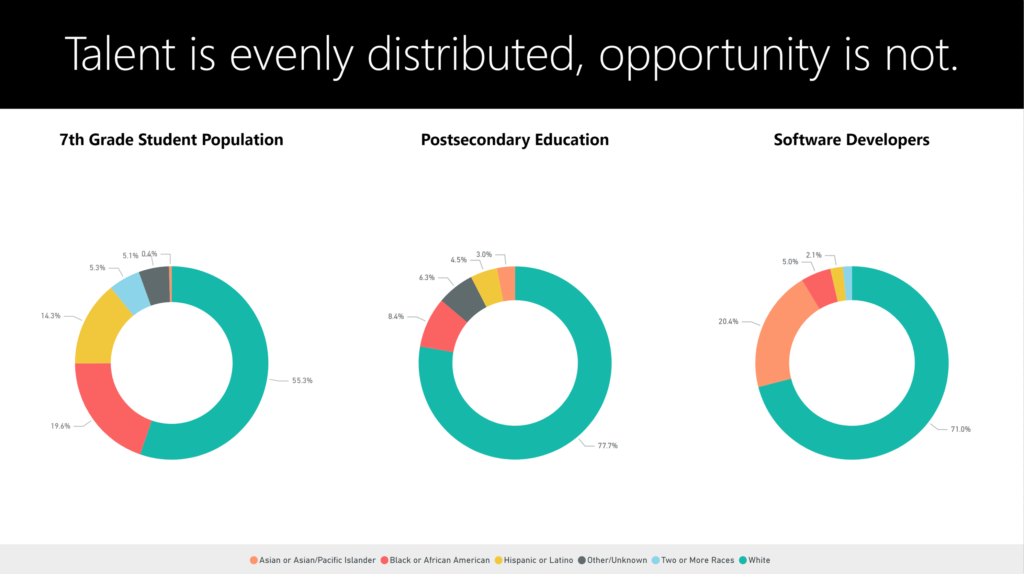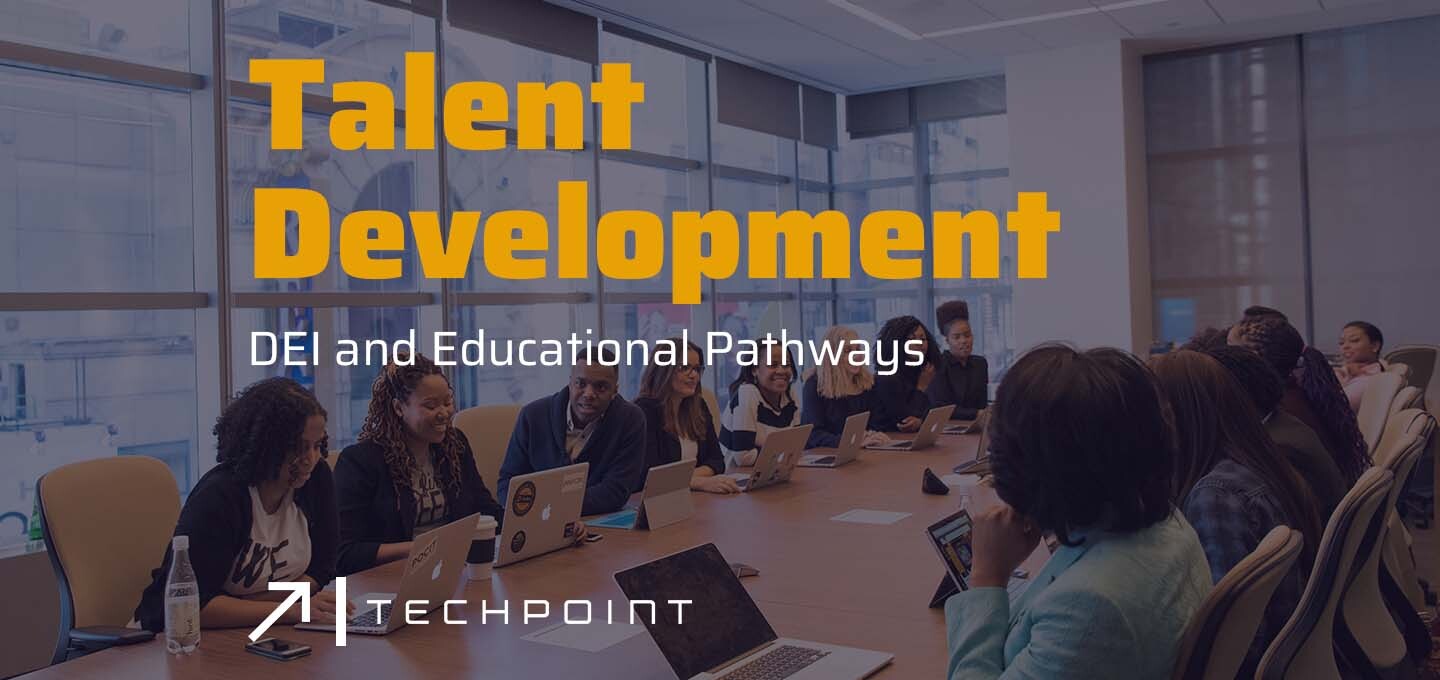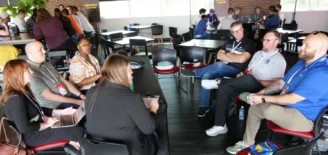Indiana must do more to put more Hoosiers of color and women onto and successfully through its tech education pathways
Finding and retaining talent is job #1 for the Indiana tech workforce, but the traditional education path is working for only a small percentage of Indiana students and employers. Indiana must resolve its issues of access, opportunity and equity if it is to develop the tech workforce that companies must have in the coming years.
Modernizing our educational pathways will be difficult, and it won’t be helped by additional factors discussed earlier on TechPoint Index like the pandemic-induced Great Resignation, the wave of Baby Boomer retirements, and a poorly-timed college enrollment cliff that alone were creating a perfect storm of tech talent supply and demand challenges. Our recent research with Fourth Economy and credible economic indicators, clearly show us an Indiana tech talent imperative: We must inclusively grow and develop the state’s tech workforce by an additional 41,000+ tech workers by 2030.

To meet this imperative, our mission as a tech ecosystem, we must correct generational imbalances and inequity by creating a more diverse and inclusive workforce. To do that, we must change mindsets and cultures. We must overcome obstacles along the talent pathway from our youths’ earliest exposure to training and education, to hiring and onboarding, and to supporting and advancing mid-career professions. We must modernize talent pathways and provide new talent on-ramps for candidates from underrepresented groups.
The tech industry nationwide has long grappled with an overwhelming lack of diversity among employees, executives, venture-backed founders, venture capital firms and board members. Despite recent efforts to increase diversity throughout the industry, tech still remains predominantly white and male. Participation rates in the tech workforce make this starkly clear:
- LatinX workers represent only 3 percent of the overall Indiana workforce while constituting 6 percent of the Indiana population.
- Black workers comprise just 7 percent of the Indiana tech workforce, while making up 10 percent of the Indiana workforce
- Women currently comprise just 28 percent of the tech workforce in Indiana, while women make up 48 percent of the overall Indiana workforce.
The data is as clear as our imperative.
Talent is evenly distributed; Opportunity is not
Indiana’s participation rates in its overall workforce reveal the progressive impact of discrimination and the blocks to opportunity. Tracking the progression of minority students over the prior decade, shows this clearly.
Back in 7th grade, 19.6 percent of current college-age students in central Indiana were Black or African American and 14.3 percent were Latino or Hispanic. Looking at Ivy Tech Community College enrollments in central Indiana, 18.2 percent of enrollments are Black or African American and 8.6 percent are Latino or Hispanic. Yet, looking at software developers in central Indiana, only 5 percent of developers are Black or African American and only 2.1 percent are Latino or Hispanic.
From middle school into the workforce, barriers and lack of access progressively reduce the participation rates of women and minorities in the tech workforce. This pattern shows that there are breakpoints all along the education and talent pathway and shows just how much work needs to be done.

How traditional on-ramps to tech careers are obstacles for too many Hoosiers
One of the challenges to developing a more inclusive and diverse tech workforce comes from the fact that the initial on-ramps into most tech roles have been uni-dimensional. As with most professional fields, tech has used university degrees and credentials as the primary educational pathway and gatekeeper to jobs in tech.
As a result, the many systemic, unconscious and sometimes deliberate barriers to college enrollment and attainment for under-represented groups have served as participation limiters for minorities in tech and tech-enabled roles.
Data from the Indiana Commission on Higher Education shows that 23 percent percent of Hoosiers complete a college degree on time, but only 11 percent of Black and LatinX students complete a degree on time.
At the same time, the tech workforce increasingly requires a higher level of training and specific technical competency.
Indiana’s post-secondary attainment patterns mirror national trends. Over the past several decades, racial and ethnic disparities in higher education enrollment and attainment have increased, along with gaps in earnings, employment, and other related outcomes for communities of color, according to the U.S. Department of Education report on “Advancing Diversity and Inclusivity in Higher Education.
The share of the population with a high school diploma has risen over time for Hispanic, Black, White and Asian adult U.S. residents, the gap in bachelor’s degree attainment has increased for both Black and Hispanic adults compared with White adults. Specifically, the gap in bachelor’s degree attainment has doubled, from 9 to 20 percent for Hispanic residents since 1974 and from 6 to 13 percent for black residents since 1964.
The participation of underrepresented students of color decreases at multiple points across the higher education pathway including at application, admission, enrollment, persistence and completion. As the report notes, “a smaller proportion of Black or Hispanic high school graduates than White graduates enroll in college, and more than 80 percent of Hispanic, Black and Asian students have a gap between their financial need and grants and scholarships, compared with 71 percent for White undergraduate students.
Degree completion rates are lower among Black and Hispanic students than White and Asian students. Nearly half of Asian students who enrolled in postsecondary education complete a bachelor’s degree, compared with fewer than one in five Hispanic and about one in five Black students.”
Nationally, research shows that 10 out of 16 million Black workers currently active in the labor market possess relevant skills obtained through routes like military service, certificate programs and community colleges that qualify them for higher-paying jobs.
Yet, when it comes to accessing well-paid, family-sustaining career opportunities in the tech sector, these high-potential candidates are left sitting on the sidelines. Research shows that when an employer requires a bachelor’s degree screen for a job, they screen out 70 percent of Black workers. In fact, nonessential degree requirements exclude two-thirds of all adults in the U.S., regardless of race, from securing a job that pays a family-sustaining wage.
Jeff Ton, an Indianapolis-based and nationally recognized expert on technology and business leadership, says these barriers persist through the hiring process and into minority career experiences.
“We have a talent gap in tech with more jobs than people to fill them. We have to expand the funnel to bring in more diverse professionals,” he said. “This is not just a hiring problem. This is also a retaining problem. Our diverse colleagues are not staying. They are leaving because they don’t feel included, they don’t feel seen.”
Five examples of how Indiana groups are working to bring diversity to the tech sector
One way Indiana is widening the traditionally narrow pathway to tech is a collaboration among the Richard M. Fairbanks Foundation, Ascend, EmployIndy, TechPoint, Conexus and other organizations called the Modern Youth Apprenticeship Program. This effort provides expanded opportunities for Indianapolis high school students to learn about tech careers, gain necessary skills, and follow new pathways into success following graduation.
Another is the national OneTen coalition, which launched in October 2020. OneTen has a bold goal of hiring 1 million Black Americans without degrees into family-sustaining, livable-wage jobs in 10 years. OneTen encourages signatories to embrace a “Skills First” hiring philosophy for at least 50 percent of their jobs; build apprenticeship programs as a way to train this targeted talent to prepare them for the available jobs; and re-credential existing jobs to open more opportunity for the targeted community.
In April, Eli Lilly and Company launched Phase 1 of its Skills First agenda by launching a Professional Apprenticeship Program. This program aims to train individuals without a four-year degree and offer them permanent jobs at Lilly. The first 10 apprentices work in Human Resources and Lilly Research Labs. The second apprentice cohort begins in August, with 15 additional apprentices working in various company departments. This program offers the opportunity for underrepresented groups to be able to close socioeconomic gaps.
This spring, Lilly in its second Skills First program, called Technical Pathway Program, focuses specifically on IT skills enabling outcomes for various capabilities across the Information and Digital Solutions (IDS) function. IDS is made up of traditional IT, Advanced Analytics & Data Science, and Digital Health positions. Its goals are to:
- Enable new entry level pathways to jobs in IDS at Lilly through intentional training and development, wrap around support, and a focus on skills development;
- Partner with a talent developer to develop a diverse pool of workers experienced and/or certified within required skill sets to work in the Indianapolis area; and
- Hire qualified individuals into a training program with the pathway to professional careers at Lilly.
TechPoint member Salesforce launched its Talent Alliance to directly address the diversity gap. Salesforce CEO Marc Benioff notes “Salesforce is committed to empowering people from every background with the skills they need to build careers and thrive in the digital economy.”
The Salesforce Talent Alliance connects employers to Salesforce candidates and brings new talent into the ecosystem, emphasizing building a diverse workforce that reflects society around the globe. Salesforce partners commit to hiring new Salesforce professionals and incorporate inclusive hiring practices. Employers are connected to certified minority candidates through workforce development groups, educational institutions, and career changers through LinkedIn and career fairs. Job seekers are trained to become Salesforce-certified professionals, with an emphasis on underrepresented groups in tech including Black, Latinx, Indigenous, Multiracial, LGBTQ+, people with disabilities, veterans and military spouses with the goal of building a more diverse, inclusive and equitable workforce.
Early stage companies in the Indiana tech ecosystem also recognize the value and importance of anchoring on diversity. Darrian Mikell, co-Founder of Qualifi, says diversity is one of his company’s strategic advantages. Having diversity is hard-wired into Qualifi’s DNA and its operations, he said.
“Diversity is integral to who we are as a company and we truly see it as a differentiating factor to our success,” he said.
Evidence and research shows simple steps can remove barriers quickly
The early successes of TechPoint members show that we can overcome our diversity challenges. Straight-forward steps like skills-first hiring can make a major impact. National research and local experience demonstrate that skills-based hiring is five times more predictive of a person’s future performance than their education, and two-and-a-half times more predictive than their prior experience. Skills-based hiring diversifies talent pools, accelerates the hiring process and increases the likelihood of retention.
Job descriptions that use gender-neutral language lead to 42 percent more responses and a two-week faster hiring time than those that use masculine language (e.g., assertive, dominant, competitive). Women tend to apply to jobs only when they meet 100 percent of the job requirements, while men will apply if they meet 60 percent. Similar gaps exist for candidates of color. And, workers who strongly agree that the job description was a good reflection of their job are 2.5 times more likely to be engaged as an employee.
There are many barriers to overcome to achieve the mission of adding 41,000+ tech workers to the Indiana workforce by 2030. For context, 41,000 new tech workers will be twice the national growth rate for tech jobs, so Indiana is facing significant challenges to fulfill this mission. Fortunately, Hoosier tech leaders and entrepreneurs are innovators and barrier busters.

TechPoint is taking the lead to ensure that Indiana’s tech community works together for the greatest impact and that we identify and address diversity gaps, and we are encouraged by initial actions, response and support.
Please continue to let me know if you know of other programs we can support or promote or if you have additional ideas.








